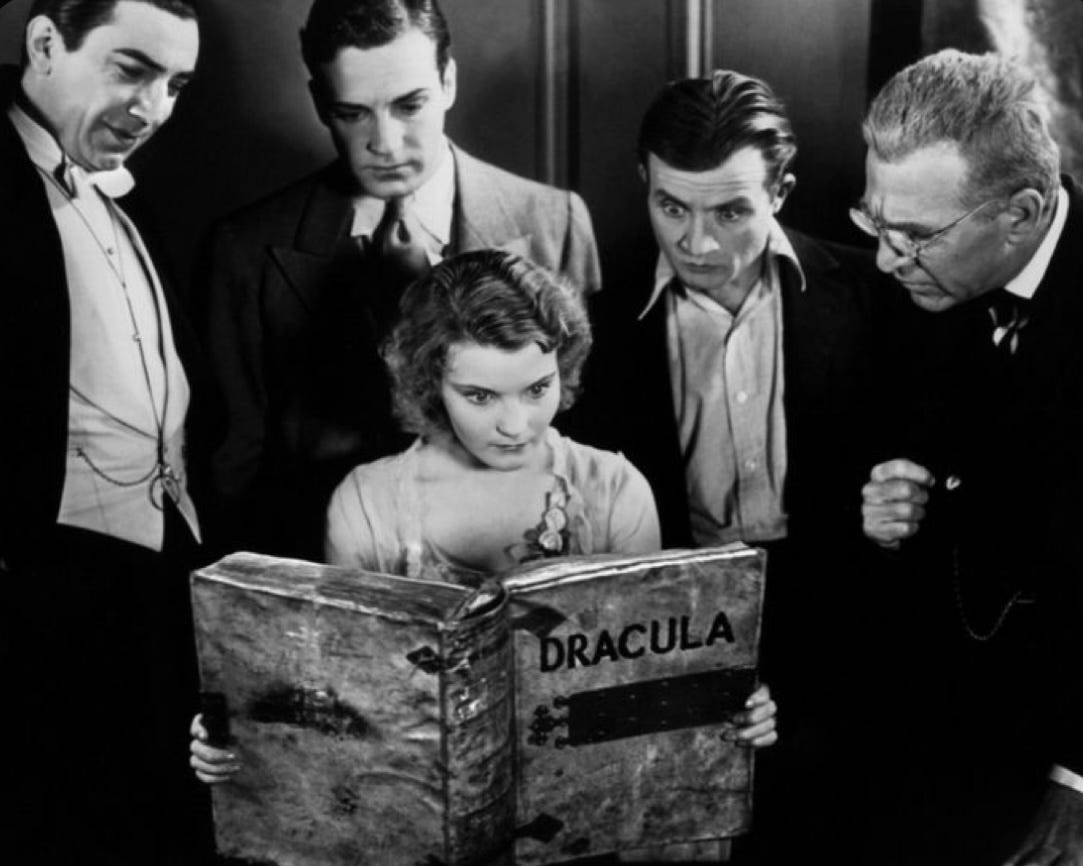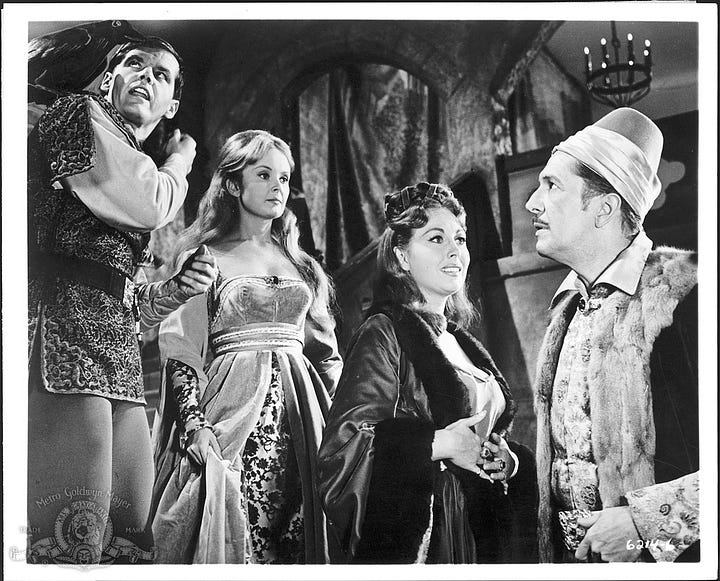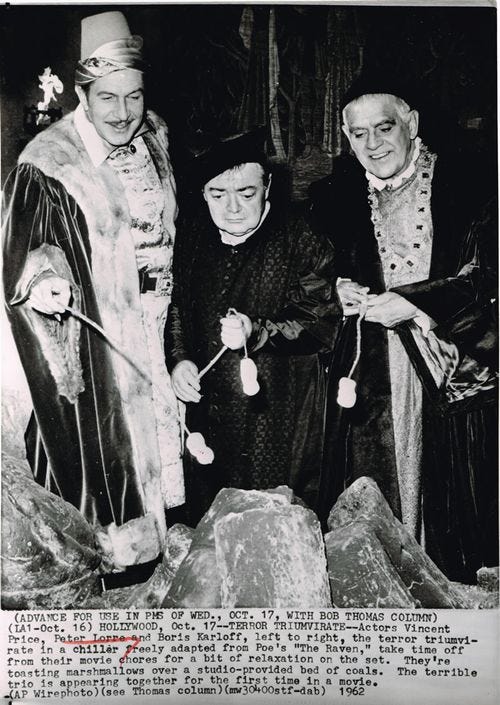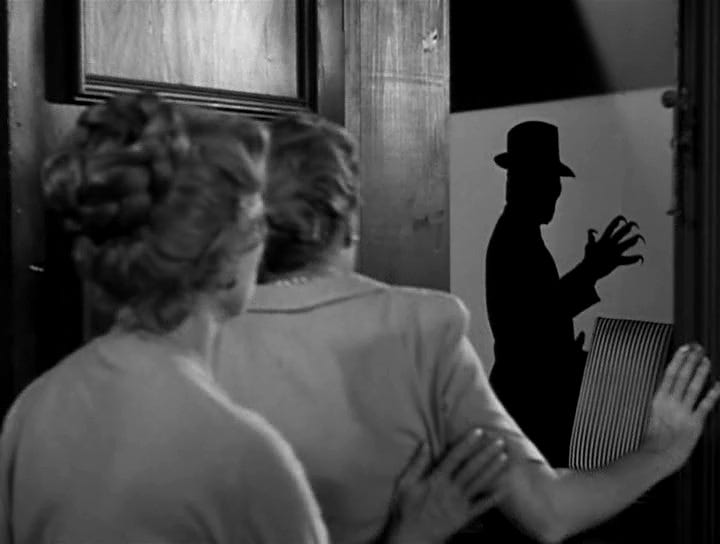In my october reflections, I talked about my strange obsession with and aversion to the horror genre. Halloween may be over, but my fascination is not, and this week we’re going to talk about an array of movies I’ve watched in the last month of my film watching journey, featuring selections from three of the great horror franchises. Wow, I’m sure you’re thinking, what could it be? Scream? Halloween? Evil Dead? Any of the other acclaimed and successful scary movie series? No!! I am of course referring to the Universal monster movies, Hammer Productions horror films, and the Corman Poe Cycle, three series full of strange films, iconic imagery, not-so-scary scares, and a lasting impact on the history of horror on film.
The Universal monster movies, a series which lasted from the 1920s through the 1950s but produced its best films during the 1930s, is an incredibly influential collection of movies which shaped the genre of horror on film, and completely transformed the pop cultural imagination of characters like Dracula, the Mummy, or Frankenstein. Across the series, many of these iconic monsters make multiple appearances, as do the performers bringing them to life, perhaps most notably(in popular culture, and for my purposes here) Béla Lugosi, the original Dracula, and Boris Karloff, best known for playing Frankenstein, both of whom also play other characters in the franchise.
Before this year, I had never watched any of these films in their entirety, and I largely wrote them off. I had this sense that they had seeped so much into pop culture that I already knew all I needed to know about them, and I had this idea in my mind of them being really corny, and poorly made. I also had a kind of snobby sense that they were not good because I knew that in the cases of Dracula and Frankenstein, they deviated in many ways from the original novels, and I was happy to imagine that they were therefore not worth watching. I am now here to say that I was wrong! These are, for the most part, really beautifully made films, full of incredibly creative effects and cinematic design. They have engaging stories, compelling performances, interesting themes. And even in the broader understanding of where they sit in the history of horror - both in connection with the 19th century novels many of them take inspiration from, and as a prelude to the next century of film, they are incredible historical texts that provide rich insight into a genre and especially to the way that the characters and iconography of monster movies have developed in the cultural imaginary.
I do not have quite as much to say about the Hammer films, mostly because I have not (yet) watched as many of them.1 These films, however, sort of act as the next chapter in the monster movie story, rebooting many of the stories made famous by their Universale predecessors. These films also feature recurring performances by actors such as Christopher Lee and Peter Cushing.
Finally, the Corman Poe Cycle is an interesting moment in horror movie history. All based to varying degrees upon the work of Edgar Allen Poe, and in large part starring Vincent Price, these films make for a pretty incredible collection of horror stories ranging from the gothic(1960’s House of Usher) to haunting period pieces(The Masque of Red Death, 1964) to horror comedy(The Raven in 1963). I really like the analysis in this Criterion article on the saga entitled “The House is the Monster”. These films are a fascinating project that delves into an array of dark themes and creates a really tight knit, aesthetically driven reimagination of Poe’s horrors for a modern audience. I think Price really stands out in each of these films as a new king of horror who is able to fully embody the haunting atmosphere that makes these films work, and he really gives his all to the most macabre, unhinged, or even comedic aspects of his roles. Before watching a few of these films, I had mostly associated him with his appearance on The Muppet Show in 1976, where he teaches Kermit the Frog the secret to turning into a vampire, and performs a campy, monster movie inspired reimagining of Carole King’s “You’ve Got a Friend” (I will be there… to brighten up even your darkest night!)
I’m sure this won’t be the last time I write about these horror movie projects, but for this newsletter, I’ve assembled a collection of six films all based around one timeless scary(or silly) theme:
it’s pretty spooky when stuff flies around at nighttime!!! aaaaah!!
I present to you, dear reader: three draculas, two ravens, and one bat.
Three Draculas
The great thing about Dracula is that I don’t really feel like I need to explain him. You get it, right? He’s a vampire. He’s called Dracula. He wants to suck your blood. Whatever.
The original novel by Irish author Bram Stoker is a classic, and I genuinely think it is worth a read. It’s full of fun stylistic choices(letters, diary entries, newspaper clippings, the 1890s equivalent of voice notes, etc.), bizarre and frightening imagery(a spooky castle, Dracula climbing around on the walls like a lizard, blood drinking, insect eating, medical trauma, hypnosis, violent deaths, mysterious and unspeakable horrors, etc.), and also a surprising amount of the text is just about administrative tasks like writing notes in shorthand and checking train schedules. What a novel!
I think the book has had a bit of a resurgence in recent years thanks to the popularity of Dracula Daily, which I highly recommend as a way to read the text.
I also feel a lot of personal attachment to Stoker and his work because of his roots in Dublin, where I often find little signs of his legacy in the neighbourhoods and spaces of my life, including the castle where he worked before becoming an author, the college he attended, and even the house he grew up in, which I lived just a minute away from for a time. There has been a lot of interesting analysis and scholarship on Stoker’s life and the themes in Dracula, including about his familial experiences with illness, his interest in Irish folklore and mythologies along with the eastern european legends which provide the basis for the Dracula myth, his (possible) queerness2 and queer themes in the novel(perhaps in conjunction with an earlier Irish vampire story, Carmilla), as well as the xenophobia and fear of the other which are represented by the titular antagonist within the text. There are a lot of different fascinating approaches to the novel and to Stoker’s writing, if you’re looking for an interesting take on this, I really enjoyed the episode “Paddy Dracula” of The Blindboy Podcast3, which talks more about Bram Stoker and the Stoker family, and explores the particularly Irish themes and experiences which may have influenced the writing of Dracula.

Dracula on Screen:
Dracula(1931)
Simply put, this is a classic. Bela Lugosi defined this character, and his performance is so fun to watch. I love the atmosphere and weirdness of this movie. It’s not perfect, certainly - the story has some issues, the movie is weirdly paced, and I find the ending to be rather sudden and anticlimactic. But it also has so many great moments - the initial introduction to Dracula and the castle, the later appearance of the Count at the opera, as he finds a point of entry into society as he moves closer in on his new victims, and the tension between Dracula and Professor Van Helsing are all compelling parts of the film, and as a whole it is a truly iconic work, which will forever hold a place in the history of the genre.
Dracula(1958)
Out of the three films here, this is probably my favourite. This was the first of the Hammer Horror films, originally titled just Dracula, but later retitled Horror of Dracula in some places to avoid being confused with the 1931 film. Christopher Lee’s Dracula is Awesome in every sense of the word, and the danger he embodies really adds to the frightening atmosphere of the film. He and Peter Cushing as Van Helsing are great foils in the story, and I find the story to be better paced and to have a much more satisfying conclusion than the previous version. This movie contributed a lot to the Dracula canon and our shared cultural understanding of the character and story, and I think it really succeeds as a reimagining of the Dracula iconography.
Bram Stoker’s Dracula(1992)
Oops! I didn’t include anything about this movie or Francis Ford Coppola in my introduction to horror up above, because, honestly, this isn’t really his lane. And listen, I hate to say this, but this is not a very good movie.
Please don’t cancel me for Coppola criticism.
I really dislike the added romance plot4 of this, and Gary Oldman is by far my least favourite Dracula. There are a lot of poor performances, including some really egregious accents(Keanu Reeves has one of the worst movie English accents I’ve ever heard, and Winona Ryder’s is not great either. While both very recognisable figures, I think they were kind of miscast in this film), and while the movie provides some incredible visual moments, some of the special effects, distracting editing choices(does every single scene need to cross fade into the next? All of them??), and other weird additions and choices really detract from the Dracula story, making for a very uneven watch that strays from the Bram Stoker vision of the tale.
On the plus side, I like that this movie finally brings back Quincey Morris, the cowboy character from the novel who has been left out of other adaptations. I also like some of the more insane costume/design choices, such as this wedding dress:
Two Ravens
In Norse mythology, Odin has two ravens named Huginn and Muninn, thought and memory; powerful, clever birds which fly through the worlds and bring him information and wisdom.
Like Odin, I also have two ravens: The Raven, from 1935 Starring Béla Lugosi as an Edgar Allen Poe enthusiast who gets a little too obsessed with recreating the dark stories of Poe in his real life(Huginn); and The Raven, a 1963 film directed by Roger Corman and starring Vincent Price, alongside horror legends Peter Lorre and Boris Karloff, as wizards(Muninn). Actually, both of my ravens feature performances from Boris Karloff(as very different characters), and I don’t have a poorly constructed mythic analogy for that, but that’s kind of weird, isn’t it?
More importantly, both films are extremely loosely based on the Edgar Allen Poe poem “The Raven”, and each contains partial recitations of the original text.
The Raven(1935)
My personal theory is that this is the original Saw. This movie is bizarre and creepy, with Dracula’s Béla Lugosi as a surgeon/Edgar Allen Poe superfan, and Boris Karloff as a runaway criminal forced by a botched plastic surgery into helping Lugosi’s character enact his plans to get revenge on the woman for whom he has developed an unrequited obsession5 after saving her from an accident(he watches her perform in one of my favourite scenes of the movie, a ballet performance paired with a recitation of the poem “The Raven”) and her father, along with a handful of other characters who he convinces to stay at his massive mansion, before it is revealed that he has built secret tunnels and traps into the house, including a recreation of the machine from the Poe story “The Pit and the Pendulum,” and that he intends to kill them all in gruesome ways in the various torture chambers hidden throughout his house. This film never gets overly gory or violent the way it might have if it had been produced in later decades, and its imperfect story sometimes overshadows its attempts to frighten, but that doesn’t stop it from being unsettling and suspenseful. After capturing his victims and unveiling his horrifying schemes, Lugosi’s character declares “I am the sanest man alive!!!” a statement simultaneously ridiculous and disturbing.6
The Raven(1963)
This movie is COMPLETELY different from its predecessor of the same name. Vincent Price is a wizard in a big spooky castle mourning the death of his wife, Lenore(played by Hazel Court, a regular player in Hammer Horror and Corman horror films, along with other wizards played by further horror veterans: Peter Lorre7 and the iconic Boris Karloff.) who gets caught up in a complex web of power and vengeance in the society of sorcerors from which he had turned his back.
The story is extremely silly, as Price’s character finds himself having to travel to Karloff’s castle, discovering secrets and threats, along with lots of goofy magic and wizard battles. This movie does not have a single truly serious scene, even turning its brief moments of violence into jokes about the bad special effects of horror movies - when Lorre’s character is seemingly killed by a magic spell, the ominous red pile of goo left behind is revealed to be strawberry jam.


As a horror comedy, I’m not sure that this movie ever quite succeeds at being either scary or funny, but there’s something about it that is so ridiculous and goofy that I find it really compelling. There’s a whole scene where Price sits on a chandelier and throws eggs at Karloff. Truly the stuff of nightmares!
Finally, I present one last movie that is not part of any of the franchises we’ve talked about thus far, but which I feel the need to include anyway: The Bat! I do not have much backstory or context to provide for this one: it’s a really weird horror-mystery movie, based on a play about a serial killer, based on a book about a spooky house. I watched this for one reason only: I saw the tagline for the film, which is “when he flies, someone dies!” and thought it was absolutely genius and hilarious. This film also features another performance from our friend Vincent Price, along with Agnes Moorehead and others. It’s the rare movie from this era that passes the Bechdel-Wallace test with ease, purely because the women in it spend so much time talking about bats.


The Bat(1959)
Agnes Moorehead plays a mystery writer staying at a remote mansion house connected to a string of mysterious murders and a loose serial killer known as “The Bat”. Vincent Price is a doctor who knows a bit too much about the true secrets of the house, and experiments with bats in his laboratory. This is a super fun mystery full of silly scares, terrible effects, and an incredible masked murderer with razor sharp claws and a love of bats. This is not a good movie but I kind of love it. The characters are all really campy and make so much out of the ridiculous situation they find themselves in, and all of the silliest moments, from a woman being bitten by what is clearly a rubber bat being thrown at her to The Bat cutting a perfect circle of glass into a door with his clawed gloves instead of just breaking in to the house. The introduction to Vincent Price’s character is also pretty amazing, and I actually found the mystery story of this strange film to be surprisingly interesting.
The last thing I will say about this movie is that the incredible tagline is kind of misleading… in spite of his name, The Bat doesn’t even fly?
I love exploring the weird side of horror as it appears in classic film and literature, and this has really given me a new appreciation for the cinematic history and spooky stories that make up this classic horror genre. In future reflections, I’ll be back to talk more about films I love from these eras, including Dracula’s Daughter, The Bride of Frankenstein, and The House of Usher, as well as other movies adjacent to or outside of the genre. In the meantime, I’ll link here to the list I put together of films I watched when thinking about these themes. I’ll also be posting the next edition of my Riverdale newsletter soon, where I’ll be exploring the show’s horror-inspired, supernatural sixth season.
Until next week, I’ll leave you with some of my moments of light this week, and some recommended reading:
I went on a lovely cross country roadtrip, most of which was spent with a corgi falling asleep on me. I got to see cool art, lots of friends, and the atlantic ocean as we drove through sun, rain, snow, and hail all in one night.
In need of some light reading this week, I’ve started reading Rick Riordan’s newest installment in the Percy Jackson series. As an elementary schooler, I was pretty much the target audience for the original series, and it has been a lovely bit of nostalgia to revisit the characters and world of the books.
We are deep into soup season, so this week I made a vegetable stew, an udon with homemade broth, and a baked french onion soup, the flavours which fuel me through the dark and cold season we find ourselves entering.
Recommendation: a collection of free ebooks in solidarity with Palestine, the link to which includes some resources for UK and US actions, as well as links to relevant short form blog posts about the struggle for Palestinian liberation if you’re looking for something quick to read.
<3 isobel
Please read the phrase “Hammer Horror” to the tune of the Kate Bush song of the same name.
There has recently been greater scholarly interest in Stoker’s personal relationships with major queer contemporaries including Oscar Wilde and Walt Whitman, which provide some context for the theory that Dracula was in part a reaction to the public scandal surrounding Wilde, the novel being first written within weeks of the infamous and widely publicised trial.
Another recent episode of the Blindboy podcast I would recommend that may be of interest - “The Return to Yurty Ahernes Couch” from 1 November, 2023. This episode starts with a story about meditation and otters, but if you want to jump to about 28 minutes in, there’s an illuminating discussion of some of the shared history of Ireland and Palestine in relation to colonial violence.
Linked here: a youtube video essay by Princess Weekes on the character of Mina Murray and the reduction of the character from a novel protagonist to an object of romantic interest for the titular vampire.
I found the criticism and analysis in this blog post quite interesting, and it offers a deeper look at and a different perspective of The Raven from what I’ve included here.
Also a great affirmation - look into the mirror every morning and tell yourself: “I am the sanest man alive” <3
I largely associate Lorre with his performance in another Halloween classic, Arsenic and Old Lace, which he had also collaborated with Karloff on in staged productions. While looking through his filmography, I came across a 1935 film called Mad Love, which has the most incredible synopsis I think I’ve ever read: “An insane surgeon’s obsession with an actress leads him to replace her wounded pianist husband’s hands with the hands of a knife murderer - hands which still have the urge to throw knives.” This movie has everything!!










